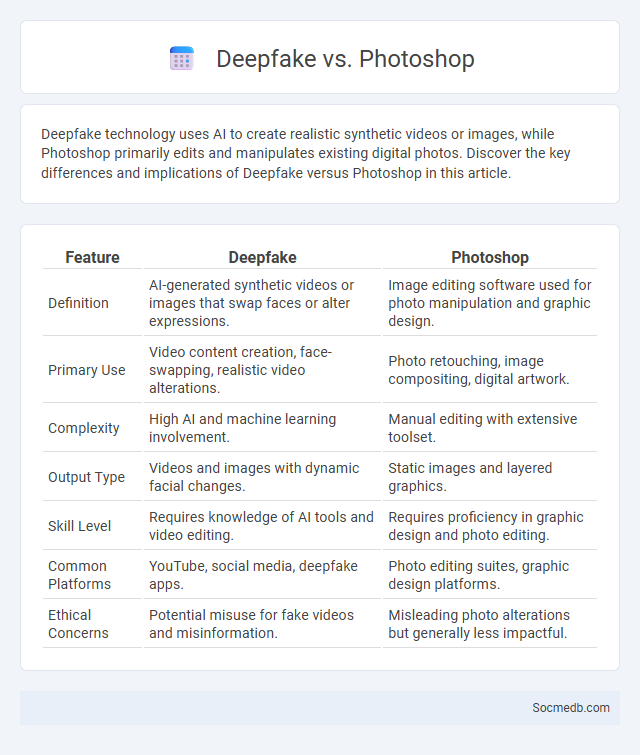
Photo illustration: Deepfake vs Photoshop
Deepfake technology uses AI to create realistic synthetic videos or images, while Photoshop primarily edits and manipulates existing digital photos. Discover the key differences and implications of Deepfake versus Photoshop in this article.
Table of Comparison
| Feature | Deepfake | Photoshop |
|---|---|---|
| Definition | AI-generated synthetic videos or images that swap faces or alter expressions. | Image editing software used for photo manipulation and graphic design. |
| Primary Use | Video content creation, face-swapping, realistic video alterations. | Photo retouching, image compositing, digital artwork. |
| Complexity | High AI and machine learning involvement. | Manual editing with extensive toolset. |
| Output Type | Videos and images with dynamic facial changes. | Static images and layered graphics. |
| Skill Level | Requires knowledge of AI tools and video editing. | Requires proficiency in graphic design and photo editing. |
| Common Platforms | YouTube, social media, deepfake apps. | Photo editing suites, graphic design platforms. |
| Ethical Concerns | Potential misuse for fake videos and misinformation. | Misleading photo alterations but generally less impactful. |
Introduction to Digital Manipulation Technologies
Digital manipulation technologies encompass advanced software tools and algorithms designed to alter images, videos, and audio on social media platforms with high precision. These technologies include deepfakes, AI-driven photo editing, and automated content enhancement, enabling creators and marketers to modify digital content seamlessly. Understanding these tools is crucial for protecting Your digital identity and ensuring the authenticity of shared media in an increasingly manipulated online environment.
What is Deepfake?
Deepfake refers to synthetic media technology that uses artificial intelligence and machine learning algorithms to create realistic but manipulated videos, images, or audio, often replacing a person's likeness with someone else's. This technology has significant implications for social media, as it can spread misinformation, deceive audiences, and create trust issues by producing highly convincing fake content. Detection tools and ethical guidelines are crucial to mitigate deepfake misuse and protect digital authenticity on social networks.
What is Photoshop?
Photoshop is a powerful image editing software developed by Adobe, widely used in social media content creation for enhancing photos, designing graphics, and producing visual effects. It offers advanced tools such as layers, masking, and filters that allow precise manipulation of images to create appealing visuals tailored for platforms like Instagram, Facebook, and Twitter. Professionals and influencers rely on Photoshop to maintain high-quality, engaging content that captures audience attention and boosts social media presence.
Deepfake vs Photoshop: Core Differences
Deepfake technology leverages artificial intelligence to create hyper-realistic videos that manipulate facial expressions and voice, whereas Photoshop primarily edits static images with manual or semi-automated tools. Deepfakes pose significant challenges for social media platforms due to their potential for misinformation and identity theft, contrasting with Photoshop's traditional role in photo enhancement and alteration. Understanding the differences between deepfake videos and Photoshop-edited images is crucial for content verification and digital media literacy.
Technology Behind Deepfake Creation
Deepfake creation relies heavily on advanced artificial intelligence techniques, particularly Generative Adversarial Networks (GANs), which enable the synthesis of hyper-realistic images and videos by pitting two neural networks against each other. These AI-driven models analyze vast datasets of facial expressions and movements to accurately mimic and manipulate visual content, making it increasingly difficult to distinguish between authentic and fabricated media. The rapid development of deep learning frameworks and increased computational power further fuel the sophistication and accessibility of deepfake technology across social media platforms.
Photoshop Techniques for Image Editing
Mastering Photoshop techniques for image editing on social media enhances the visual appeal of your content, driving higher engagement and follower growth. Utilizing tools like layers, masks, and adjustment filters allows you to fine-tune colors, remove imperfections, and create professional-grade images tailored to platform algorithms. Your skill in optimizing photos with techniques such as retouching, resizing, and compositing directly impacts the effectiveness of your social media presence.
Use Cases: Deepfake in Video vs Photoshop in Images
Deepfake technology in video allows for the creation of highly realistic manipulated footage that can alter facial expressions, speech, and actions, posing significant risks for misinformation and identity theft on social media platforms. Photoshop in images enables detailed photo editing, retouching, and creative alterations but is generally easier to detect due to static content and common visual cues. Both tools are extensively used for entertainment, marketing, and political campaigns, but the dynamic nature of deepfakes in video presents unique challenges for verification and digital content authenticity.
Ethical Implications and Risks
Social media platforms raise significant ethical concerns regarding privacy breaches, misinformation dissemination, and data exploitation. Algorithms designed to maximize user engagement often prioritize sensational or misleading content, amplifying social polarization and mental health issues. Regulatory frameworks and transparent practices are essential to mitigate risks and uphold digital ethics in social networking environments.
Detection and Prevention Methods
Advanced social media detection and prevention methods employ AI algorithms and machine learning to identify and mitigate harmful content, fake profiles, and misinformation swiftly. You can protect your online presence by utilizing platform-specific privacy settings, enabling content filters, and reporting suspicious activities promptly. Continuous monitoring and proactive moderation help maintain a safe and trustworthy social media environment.
Future Trends: Deepfake and Photoshop Evolution
The future of social media will be significantly impacted by advancements in deepfake technology and Photoshop evolution, enabling hyper-realistic image and video manipulation that challenges the authenticity of shared content. Enhanced AI algorithms and machine learning models will allow for more seamless and undetectable alterations, increasing the necessity for robust verification tools and digital literacy among users. This rapid progression will drive social media platforms to innovate stricter content moderation policies and integrate advanced detection systems to combat misinformation and maintain trust.
 socmedb.com
socmedb.com